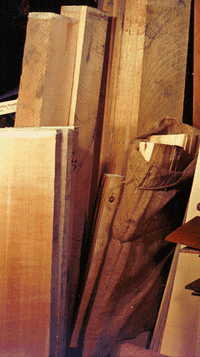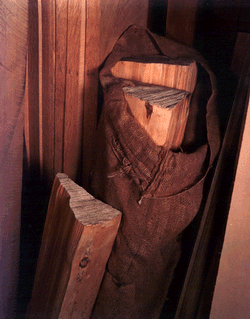
SPRUCE

These planks of Sitka spruce are 3" thick and 18" wide... they were cut from a cant 18" square and 24' long they were air dried in planks for 15 years before being resawn into bookmatchedtops and seasoned in a controlled environment for another 10 years the grain is very straight and uniform and averages about 24 lines to the inch. Because it is quarter sawn the end grain is perfectly perpendicular to the face of the plank, and the incidence of silky-flame (medullary rays) is very dramatic. |
As the famous Spanish builder, Torres, has already demonstrated, the soundboard is the primary generator of sound in the guitar. Spruce and cedar tops have been fabricated from a variety of species over the years in the search for the definitive soundboard material. There are many schools of thought about which variety of spruce is best; many builders swear by the European variety known as German silver spruce, or Bavarian spruce (Picea excelsa) and (Picea abies). The availability of the best examples of European spruces has been severely reduced due to centuries of over harvesting. The current selection of European spruces is in most cases no better than domestic varieties, which are readily available and typically superior in quality. In addition to European spruce and Sitka spruce, I also use a high altitude variety from the Canadian Rockies known as Engelmann spruce (Picea engelmannii) as well as the very rare eastern variety Adirondack spruce (Picea glauca) I use cedar as well, both the familiar western red cedar(Thuja plicata) and a less familiar variety from the Oregon coast known as Port Orford cedar (Chamaecyparis lawsoniana) which is superb when used as a soundboard in lutes and other historical reproductions. |
| In my estimation the well informed builder will select the individual soundboard from the species listed above, based more upon the qualities inherent in the individual selection, than choosing a soundboard material based on reputation alone. After all, a sitka spruce top exhibiting outstanding characteristics will obviously out perform a European variety having only mediocre qualities. Regardless of the material used a good builder will modify top thickness and brace placement to wrench the best sound possible from the instrument. |

Pictured here are split billets of Port Orford cedar and spruce from Europe. Split wood is always superior to its sawn counterparts, and thus preferable for sound boards and braces. |
copyright 1997, anthony huvard, http://www.cybozone.com site maintained by cyboboy@cybozone.com